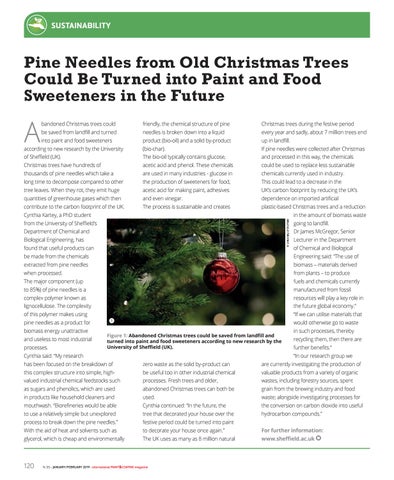SUSTAINABILITY
Pine Needles from Old Christmas Trees Could Be Turned into Paint and Food Sweeteners in the Future
A
bandoned Christmas trees could
friendly, the chemical structure of pine
Christmas trees during the festive period
be saved from landfill and turned
needles is broken down into a liquid
every year and sadly, about 7 million trees end
into paint and food sweeteners
product (bio-oil) and a solid by-product
up in landfill.
according to new research by the University
(bio-char).
If pine needles were collected after Christmas
of Sheffield (UK).
The bio-oil typically contains glucose,
and processed in this way, the chemicals
Christmas trees have hundreds of
acetic acid and phenol. These chemicals
could be used to replace less sustainable
thousands of pine needles which take a
are used in many industries - glucose in
chemicals currently used in industry.
long time to decompose compared to other
the production of sweeteners for food,
This could lead to a decrease in the
tree leaves. When they rot, they emit huge
acetic acid for making paint, adhesives
UK’s carbon footprint by reducing the UK’s
quantities of greenhouse gases which then
and even vinegar.
dependence on imported artificial
contribute to the carbon footprint of the UK.
The process is sustainable and creates
plastic-based Christmas trees and a reduction in the amount of biomass waste © University of Sheffield
Cynthia Kartey, a PhD student from the University of Sheffield’s Department of Chemical and Biological Engineering, has found that useful products can
going to landfill. Dr James McGregor, Senior Lecturer in the Department of Chemical and Biological
be made from the chemicals
Engineering said: “The use of
extracted from pine needles
biomass – materials derived
when processed.
from plants – to produce
The major component (up
fuels and chemicals currently
to 85%) of pine needles is a
manufactured from fossil
complex polymer known as
resources will play a key role in
lignocellulose. The complexity
the future global economy.”
of this polymer makes using pine needles as a product for biomass energy unattractive and useless to most industrial processes.
“If we can utilise materials that
1
would otherwise go to waste
Figure 1: Abandoned Christmas trees could be saved from landfill and turned into paint and food sweeteners according to new research by the University of Sheffield (UK).
Cynthia said: “My research
in such processes, thereby recycling them, then there are further benefits.” “In our research group we
has been focused on the breakdown of
zero waste as the solid by-product can
are currently investigating the production of
this complex structure into simple, high-
be useful too in other industrial chemical
valuable products from a variety of organic
valued industrial chemical feedstocks such
processes. Fresh trees and older,
wastes, including forestry sources, spent
as sugars and phenolics, which are used
abandoned Christmas trees can both be
grain from the brewing industry and food
in products like household cleaners and
used.
waste; alongside investigating processes for
mouthwash.b“Biorefineries would be able
Cynthia continued: “In the future, the
the conversion on carbon dioxide into useful
to use a relatively simple but unexplored
tree that decorated your house over the
hydrocarbon compounds.”
process to break down the pine needles.”
festive period could be turned into paint
With the aid of heat and solvents such as
to decorate your house once again.”
For further information:
glycerol, which is cheap and environmentally
The UK uses as many as 8 million natural
www.sheffield.ac.uk
120
N. 55 - JANUARY/FEBRUARY 2019 - international PAINT&COATING magazine
